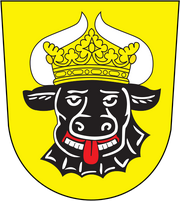
Coat of arms of Mecklenburg.
Mecklenburg is a historical region in northern Germany comprising the western and larger part of the federal-state Mecklenburg-Vorpommern. The largest cities of the region are Rostock, Schwerin, and Neubrandenburg.
The name Mecklenburg derives from a castle named "Mikilenburg" (Old German: "big castle"), located between the cities of Schwerin and Wismar. It was the ancestral seat of the House of Mecklenburg and for a time divided into Mecklenburg-Schwerin and Mecklenburg-Strelitz among the same dynasty.
Linguistically, Mecklenburgers retain and use many features of the Plattdeutsch, or Low German. dialects or language.
Mecklenburg in 1632[]
Mecklenburg was ruled by its more conservative and aristocratic nobles, and was very reluctant to accept social changes after being admitted to the United States of Europe. The region's nobility was particularly hostile to the Committees of Correspondence. Within the USE, it was one of the two provinces directly ruled by Gustavus Adolphus, who had named himself Duke of Mecklenburg.
In the wake of the "Dreeson Incident", the Committees of Correspondence entered Mecklenburg to eradicate its anti-Semites during Operation Kristallnacht. The Mecklenburg nobility militarily resisted this incursion. While they had some initial success, a low-level civil war developed in the region. What turned things around was the "unofficial" involvement of the USE's air force base in Wismar, whose commanders looked the other way while "training flights" used up large amounts of ammunition and "happened" to bomb the nobility's forces. This created a stalemate which gave the CoC's national leadership time to bring in reinforcements.
These reinforcements were better armed than the Mecklenberger nobility's forces, had radios, and had the benefit of aerial reconnaissance, even if the planes were no longer bombing. Near Güstrow, the nobility's forces were routed, and news of their defeat sparked a peasant revolt. The CoC forces, this time led by Gretchen Richter herself, informally got in front of the revolt under the slogan "Long Live the Duke!", as it was well-known that Gustavus, in his capacity as Duke of Mecklenburg, had frequently clashed with the local nobility. As a result, the Mecklenburg nobility fled the province, and it became a stronghold of the CoCs and the Fourth of July Party.[1] In fact, Mecklenburg's capital, Schwerin, became known as a hotbed of radicalism.
In January 1636, the exiled Mecklenburger nobility tried to move back into the province. However, the province's CoC had managed to organize a fairly decent militia, and to fortify the major towns. The forces of the nobility were stopped on the outskirts of Wittstock, and then decided to bypass Wittstock and move on Schwerin. However, they were finally stopped at Lake Müritz by forces which included former members of the USE Army, and never reached Schwerin. This was the only clash in the USE's civil unrest that took place outside of Saxony.[2]
Historical note[]
There was a Gustav Adolph who was duke of Mecklenburg-Güstrow from 1636 to 1695. While he was no relation to Gustavus, he may have been a namesake. Since he was born in 1633, he may not exist in the NTL, and will certainly have a very different life if he does.
References[]
- ↑ 1635: The Dreeson Incident, ch. 68
- ↑ 1636: The Saxon Uprising, ch. 22